3.7 Genetics, populations, evolution and ecosystems
1/55
There's no tags or description
Looks like no tags are added yet.
Name | Mastery | Learn | Test | Matching | Spaced |
|---|
No study sessions yet.
56 Terms
What is meant by the term genotype?
Genetic constitution of an organism
What is meant by the term phenotype?
The expression of this genetic constitution (genotype) and its interaction with the environment
What are alleles and how do they arise?
Variations of a particular gene (same locus) → arise by mutation (changes in DNA base sequence)
How many alleles of a gene can be found in diploid organisms?
● 2 as diploid organisms have 2 sets of chromosomes (chromosomes are found in homologous pairs)
○ But there may be many (more than 2) alleles of a single gene in a population
Describe the different types of alleles
Dominant allele: Always expressed (shown in the phenotype)
Recessive allele: Only expressed when 2 copies present (homozygous recessive)/ NOT expressed when dominant allele present (heterozygous)
Codominant alleles: Both alleles expressed / contribute to phenotype (if inherited together)
What is meant by the terms homozygous and heterozygous?
Homozygous Alleles: at a specific locus (on each homologous chromosome) are the same
Heterozygous Alleles: at a specific locus (on each homologous chromosome) are different
What do monohybrid and dihybrid crosses show?
● Monohybrid cross - inheritance of one phenotypic characteristic coded for by a single gene
● Dihybrid cross - inheritance of two phenotypic characteristics coded for by two different genes
Explain the evidence from a pedigree diagram which would show that the allele for [named phenotype] is dominant
● [Named phenotype] parents [n & n] have child [n] WITHOUT [named phenotype]
● So both parents [n & n] must be heterozygous / carriers of recessive allele
○ If it were recessive, all offspring would have [named phenotype]
Explain the evidence from a pedigree diagram which would show that the allele for [named phenotype] is recessive
● Parents [n & n] WITHOUT [named phenotype] have child [n] WITH [named phenotype]
● So both parents [n & n] must be heterozygous / carriers of recessive allele
What is a sex-linked gene?
A gene with a locus on a sex-chromosome (normally X)
Explain why males are more likely to express a recessive X-linked allele
This assumes males are XY and females are XX, as in humans. In some organisms, it is swapped. In these cases, females (XY) would be more likely to express a recessive X-linked allele.
● Females (XX) have 2 alleles → only express recessive allele if homozygous recessive / can be carriers
● Males (XY) have 1 allele (inherited from mother) → recessive allele always expressed
Explain the evidence from a pedigree diagram which would show that the allele for [named phenotype] on the X-chromosome is recessive
● Mother [n] WITHOUT [named phenotype] has child [n] WITH [named phenotype]
● So mother [n] must be heterozygous / carrier of recessive allele
Explain the evidence from a pedigree diagram which would suggest that [named recessive phenotype] is caused by a gene on the X chromosome
Only males tend to have [named recessive phenotype]
Explain the evidence from a pedigree diagram which would show that the gene for [named phenotype] is not on the X chromosome
● [Named phenotype] father [n] has daughter [n] WITHOUT [named phenotype]
● Father [n] would pass on allele for [named phenotype] on X chromosome so
daughter [n] would have [named phenotype]
OR
● [Named phenotype] mother [n] has son [n] WITHOUT [named phenotype]
● Mother [n] would pass on allele for [named phenotype] on X chromosome so
son [n] would have [named phenotype]
(this assumes males are XY and females are XX, as in humans. There has been a question previously about birds where males are XX and females are XY. In this case, swap father for mother and son for daughter.)
Explain how autosomal linkage affects inheritance of alleles
● Two genes located on same autosome (non-sex chromosome)
● So alleles on same chromosome inherited together
○ Stay together during independent segregation of homologous chromosomes during meiosis
● But crossing over between homologous chromosomes can create new combinations of alleles
○ If the genes are closer together on an autosome, they are less likely to be split by crossing over
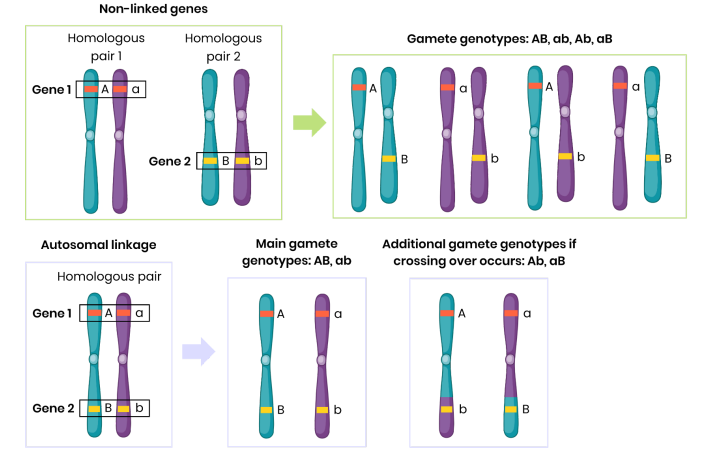
What is epistasis?
Interaction of (products of) non-linked genes where one masks / suppresses the expression of the other
Describe when a chi-squared (X^2) test can be used
● When determining if observed results are significantly different from expected results (frequencies)
○ Eg. comparing the goodness of fit of observed phenotypic ratios with expected ratios
● Data is categorical (can be divided into groups eg. phenotypes)
Suggest why in genetic crosses, the observed phenotypic ratios obtained in the offspring are often not the same as the expected ratios
● Fusion / fertilisation of gametes is random
● Autosomal linkage / epistasis / sex-linkage
● Small sample size → not representative of whole population
● Some genotypes may be lethal (cause death)
Describe how a chi-squared value can be calculated

Describe how a chi-squared value can be analysed
1. Number of degrees of freedom = number of categories - 1 (eg. 4 phenotypes = 3 degrees of freedom)
2. Determine critical value at p = 0.05 (5% probability) from a table
3. If X 2 value is [greater / less] than critical value at p < 0.05
○ Difference [is / is not] significant so [reject / accept] null hypothesis
○ So there is [less / more] than 5% probability that difference is due to chance
What is a population?
● A group of organisms of the same species in a particular space at a particular time
● That can (potentially) interbreed (to produce fertile offspring)
What is a gene pool?
All the alleles of all the genes in a population at any one time
What is allele frequency?
Proportion of an allele of a gene in a gene pool (decimal or percentage)
What does the Hardy-Weinberg principle state and what are the conditions under which the principle applies?
● Allele frequencies will not change from generation to generation, given:
○ Population is large
○ No immigration / emigration (to introduce / remove alleles)
○ No mutations (to create new alleles)
○ No selection for / against particular alleles
○ Mating is random
What is the Hardy-Weinberg equation?

Explain why individuals within a population of a species may show a wide range of variation in phenotype
● Genetic factors
○ Mutations = primary source of genetic variation
○ Crossing over between homologous chromosomes during meiosis
○ Independent segregation of homologous chromosomes during meiosis
○ Random fertilisation of gametes during sexual reproduction
● Environmental factors (depends on context - eg. food availability, light intensity)
What is evolution?
● Change in allele frequency over time / many generations in a population
● Occurring through the process of natural selection
Describe factors that may drive natural selection
● Predation, disease and competition for the means of survival
● These result in differential survival and reproduction, ie. natural selection
Explain the principles of natural selection in the evolution of populations (MARIA
1. Mutations: Random gene mutations can result in [named] new alleles of a gene
2. Advantage: Due to [named] selection pressure, the new allele might benefit its possessor [explain why] → organism has a selective advantage
3. Reproduction: Possessors are more likely to survive and have increased reproductive success
4. Inheritance: Advantageous allele is inherited by members of the next generation (offspring)
5. Allele frequency: Over many generations, [named] allele increases in frequency in the gene pool
Explain the effects of stabilising selection
● Organisms with alleles coding for average / modal variations of a trait have a selective advantage (eg. babies with an average weight)
● So frequency of alleles coding for average variations of a trait increase and those coding for extreme variations of a trait decrease
● So range / standard deviation is reduced
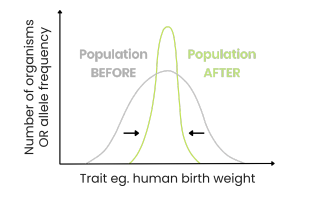
Explain the effects of directional selection
● Organisms with alleles coding for one extreme variation of a trait have a selective advantage (eg. bacteria with high resistance to an antibiotic)
● So frequency of alleles coding for this extreme variation of the trait increase and those coding for the other extreme variation of the trait decrease
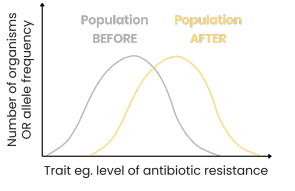
Explain the effects of disruptive selection
● Organisms with alleles coding for either extreme variation of a trait have a selective advantage
● So frequency of alleles coding for both extreme variations of the trait increase and those coding for the average variation of the trait decrease
● This can lead to speciation


Describe speciation (how new species arise from existing species)
1. Reproductive separation of two populations (of the same species)
2. This can result in accumulation of differences in their gene pools
3. New species arise when these genetic differences lead to an inability of members of the populations to interbreed and produce fertile offspring
Describe allopatric speciation
1. Population is split due to geographical isolation (eg. new river formed)
2. This leads to reproductive isolation, separating gene pools by preventing interbreeding / gene flow between populations
3. Random mutations cause genetic variation within each population
4. Different selection pressures / environments act on each population
5. So different advantageous alleles are selected for / passed on in each population
6. So allele frequencies within each gene pool change over many generations
7. Eventually different populations cannot interbreed to produce fertile offspring
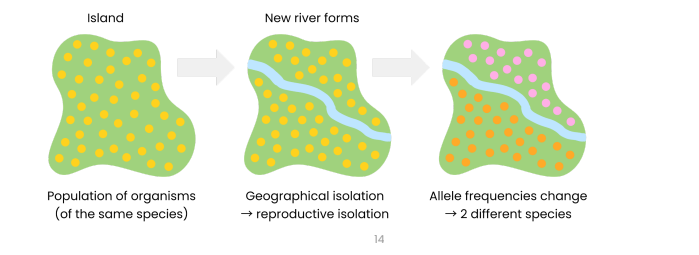
Describe sympatric speciation
1. Population is not geographically isolated
2. Mutations lead to reproductive isolation, separating gene pools by preventing interbreeding / gene flow within one population, eg.
○ Gamete incompatibility
○ Different breeding seasons (eg. different flowering times)
○ Different courtship behaviour preventing mating
○ Body shape / size changes preventing mating
3. Different selection pressures act on each population
4. So different advantageous alleles are selected for / passed on in each population
5. So allele frequencies within each gene pool change over many generations
6. Eventually different populations cannot interbreed to produce fertile offspring
Explain genetic drift and its importance in small populations
● Genetic drift = a mechanism of evolution in which allele frequencies in a population change over generations due to chance (NOT natural selection)
● Some alleles are passed onto offspring more / less often by chance
○ Regardless of selection pressures and whether alleles give a selective advantage
● So strongest effects in small populations with no interbreeding with other populations (no gene
flow), as gene pool is small and chance has a greater influence
○ Eg. when a population is sharply reduced in size (bottleneck effect)
○ Eg. when a small, new colony forms from a main population (founder effect)
● This can reduce genetic diversity - some alleles have much higher frequencies, others are lost
What is a community?
All the populations of different species living in
the same place (habitat) at the same time
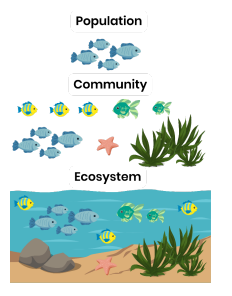
What is an ecosystem?
A community and the non-living (abiotic) components of its environment, Ecosystems can range in size from very small to very large and they are dynamic systems (populations rise / fall over time)
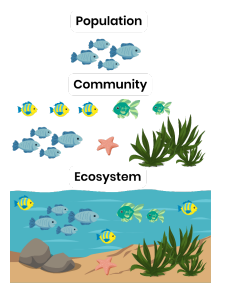
What is a niche?
● The specific role of a species within its habitat, eg. what it eats, where and when it feeds
● Governed by its adaptation to both abiotic (non-living) and biotic (living) conditions
Explain the advantage of species occupying different niches
● Less competition for food / resources
● If two species tried to occupy the same niche, one would outcompete the other
What is carrying capacity?
The maximum (stable) population size of a species that an ecosystem can support
List the factors that influence carrying capacity
Abiotic factors:
Eg. light intensity, temperature, soil pH & mineral content, humidity
Interactions between organisms:
a. Interspecific competition - between organisms of different species
b. Intraspecific competition - between organisms of the same species
c. Predation (predators kill and eat other animals, called prey)
Explain how abiotic factors may affect population size / carrying capacity
● If conditions favourable, organisms more likely to survive & reproduce → increasing carrying capacity
● Eg. increasing light intensity increases rate of photosynthesis, increasing nitrates increases protein production and increasing phosphates increases phospholipid production in plants
○ This increases carrying capacity of a variety of plant species
○ So increases the number and variety of habitats, niches and food sources for animals
○ So increasing carrying capacity of a variety of animal species
Explain how interspecific competition may affect population size
● Reduces [named resource] available to both species, limiting their chances of survival & reproduction
○ So reduces population size of both species
● If one species is better adapted, it will outcompete the other
○ So population size of less well adapted species declines, potentially leading to extinction
Explain how intraspecific competition may affect population size
1. As population size increases, resource availability per organism decreases, so competition increases
○ So chances of survival & reproduction decrease → population size decreases
2. As population size decreases, resource availability per organism increases, so competition decreases
○ So chances of survival & reproduction increase → population size increases
Explain the changes which occur in populations of predators & prey
Populations fluctuate in cycles, the predator population peaking after the prey (lag time):
1. Prey population increases so predators have more food
○ So more predators survive & reproduce
2. Predator population increases so more prey killed & eaten
○ So less prey survive & reproduce
3. Prey population decreases so predators have less food
○ So less predators survive & reproduce
4. Predator population decreases so less prey killed & eaten
○ So more prey survive & reproduce (cycle repeats)
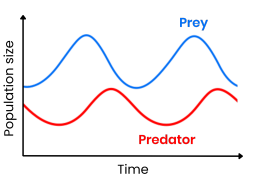
Describe how the size of a population of slow-moving or non-motile organisms can be estimated
1. Divide area into a grid / squares eg. place 2 tape measures at right angles
2. Generate a pair of coordinates using a random number generator (eg. on a calculator)
3. Place a quadrat here and count number / frequency of [named species]
4. Repeat a large number of times (10 or more) and calculate a mean per quadrat
5. Population size = (total area of habitat / quadrat area) x mean per quadrat
Describe how the mark-release-recapture method can be used to estimate the size of a population of motile organisms
● Capture sample of species, mark and release
● Ensure marking is not harmful / does not affect survival
● Allow time for organisms to randomly distribute before collecting second sample
● Population = (number in sample 1 x number in sample 2) / number marked in sample 2
(marking doesn’t have to be physical. It could be recording the base sequence, for example. Recapturing an organism with an identical base sequence would show the organism has been caught (‘marked’) before.)
Explain how the mark release recapture equation can be derived

What assumptions does the mark-release recapture method make?
1. Sufficient time for marked individuals to mix / distribute evenly within the population
2. Marking not removed so marked organisms are recaptured OR marking is not toxic so doesn’t
affect chances of survival OR marking not visible (to predators) so doesn't affect predation
3. Limited / no immigration / emigration
4. No / few births / deaths / breeding / change in population size (or birth & death rate are equal)
Suggest why the mark-release-recapture method can produce unreliable results in very large areas
● Unlikely that organisms will distribute randomly / evenly
● Less chance of recapturing organisms (that were marked initially)
Succession
change in a community over time due to change in abiotic factors / species
Describe and explain how primary succession occurs
1. Colonisation by pioneer species (first to colonise)
2. Pioneer species (and other species at each stage in succession) change abiotic conditions
○ Eg. they die and decompose, forming soil which retains water (humus / organic matter)
3. So environment becomes less hostile / more suitable for other species with different adaptations AND less suitable for previous species, so better adapted species outcompete previous species
4. As succession goes on, biodiversity increases
5. Climax community reached - final stable community (no further succession)
Describe features of a climax community
● Same species present / stable community over a long time
● Abiotic factors (fairly) constant over time
● Populations (fairly) stable (around carrying capacity)
Explain how conservation of habitats involves management of succession
● Further succession can be prevented to stop a climax community forming
○ By removing or preventing growth of species associated with later stages eg. by allowing grazing
● This preserves an ecosystem at a certain point / in its current stage of succession (plagioclimax)
● So early species are not outcompeted by later species and habitats / niches are not lost
Describe the conflict between human needs and conservation as well as the importance of managing this
● Human demand for natural resources (eg. timber) is leading to habitat destruction / biodiversity loss
● Conservation is needed to protect habitats / niches / species / biodiversity
● Management of this conflict maintains the sustainability of natural resources
○ Meeting current needs without compromising the ability of future generations to meet theirs